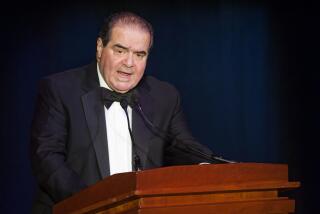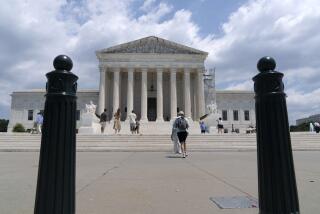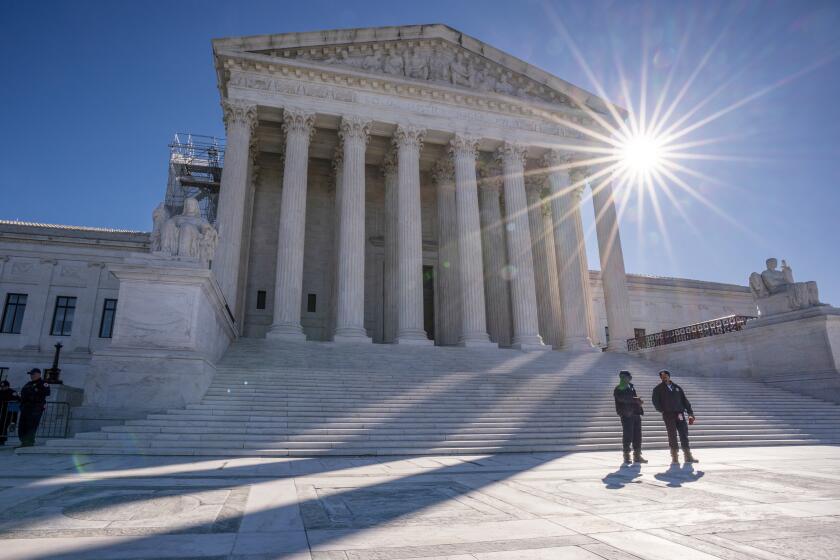A Burning Cross May Get Justices’ Attention
- Share via
WASHINGTON — Four years ago, the Ku Klux Klan gathered on a farm in rural southwestern Virginia for an old-fashioned summer evening of singing hymns and spewing hate.
One speaker told of his wish to use a high-powered rifle to “shoot the blacks and the Mexicans.” Another ranted about then-President Clinton and his wife, Hillary. The night was capped by the singing of “Amazing Grace” and the lighting of a 30-foot cross, easily visible from a nearby state highway.
A county sheriff, who was there observing the rally, then calmly informed Klansman Barry Elton Black that he was under arrest for violating the state’s 50-year-old law against cross burning.
Virginia’s law, like those of at least a dozen other states, including California, makes it a crime to burn a cross or display a swastika for the purpose of “intimidating” or “terrorizing” others.
Last year, the Virginia Supreme Court joined the growing trend in state courts when it threw out the klansman’s conviction and struck down the law as a violation of the 1st Amendment right to free speech.
“Under our system of government, people have the right to use symbols to communicate,” the Virginia judges said in a 4-3 ruling. “They may patriotically wave the flag or burn it in protest; they may reverently worship the cross or burn it as an expression of bigotry.”
This week, the Supreme Court is being urged to take up the cross-burning case and to preserve the state laws against displays of bigotry and hatred.
In his appeal, Virginia Atty. Gen. Jerry Kilgore called cross burning a kind of “domestic terrorism.”
In recent years, courts in Maryland, New Jersey and South Carolina have invalidated their cross-burning laws. They have done so even in cases in which young skinheads burned crosses on the property of African Americans.
Collectively, the rulings illustrate the continuing legal dispute over how to draw a line between protected free speech and illegal threats and intimidation.
“Today, a burning cross--standing alone and without explanation--is typically understood in our society as a message of intimidation,” Kilgore said. “This is so, regardless of the race, religion or other characteristics of the individual targeted.”
In his appeal, he noted that the state court ruling also threw out charges against two Virginia Beach men who burned a cross outside the home of a black family that had just moved into the neighborhood.
California Atty. Gen. Bill Lockyer joined his counterparts in Arizona, Georgia, Kansas, Massachusetts, Missouri, Oklahoma, Utah and Washington in urging the high court to take up Virginia’s appeal.
Officials in Lockyer’s office say prosecutors in California have brought 24 charges under the cross-burning law since 1995.
Unlike the Virginia law, however, California’s measure is limited to those who “burn or desecrate a cross or other religious symbol ... on the private property of another” for the “purpose of terrorizing” others. This exempts those who burn a cross on their own property.
The justices may act on the appeal in the case, Commonwealth of Virginia vs. Black, 01-1107, as soon as this week.
If the court turns down Virginia’s appeal, it would suggest that all the cross-burning laws, including California’s, are vulnerable to constitutional challenge.
Much of the dispute turns on the meaning of a Supreme Court ruling 10 years ago that struck down a cross-burning ordinance in St. Paul, Minn. A teenage skinhead, identified only as R.A.V., had been convicted of burning a cross outside the home of a black family, but his lawyers challenged the ordinance as unconstitutional. Agreeing, Justice Antonin Scalia wrote that the government cannot “impose special prohibitions” on expressions of “disfavored subjects.”
Scalia’s opinion in R.A.V. vs. St. Paul seemed to target political correctness, and it was used as a basis for striking down campus speech codes that banned the use of certain demeaning words and offensive expressions.
It has been unclear, however, whether his opinion was intended to strike down all cross-burning laws or only those targeting acts motivated by racial or religious bigotry.
The state courts in California, Florida and Washington took the latter view and upheld their cross-burning laws against free-speech attacks, despite the Supreme Court’s ruling.
The cross-burning case is not the only one that raises the difficult issue of how to draw a line between protected free speech and illegal threats and intimidation.
Two weeks ago, the U.S. 9th Circuit Court of Appeals in San Francisco split 6 to 5 on whether antiabortion extremists could be sued and forced to pay millions of dollars in damages for having drawn up “wanted posters” that display the names and faces of abortion doctors. Some doctors who were slain were crossed out.
The six judges in the majority said these posters were intended “to intimidate physicians from providing reproductive health services.” Because the posters “amounted to a true threat,” they are “not protected speech,” wrote Judge Pamela A. Rymer for the appeals court.
The five dissenters conceded the posters were intended to intimidate abortion doctors and even frighten them into changing their practices. However, they said the “wanted posters” were not true threats because no one had directly targeted an individual for immediate violence.
“Some forms of intimidation enjoy constitutional protection,” wrote Judge Alex Kozinski in dissent.
The issue itself is one of the oldest in 1st Amendment law.
In 1919, Justice Oliver Wendell Holmes famously observed that words that present a “clear and present danger” to incite lawbreaking are outside the protections of the 1st Amendment. Holmes spoke for a unanimous court in upholding the conviction of a Socialist Party leader who printed leaflets that condemned the World War I draft.
But years later, the court gave the “clear and present danger” test more teeth.
In 1931, the high court threw out the conviction of Yetta Stromberg, who had been charged with violating California’s “red flag” law. She carried a Soviet flag at a children’s camp of the Young Communist League, but the Supreme Court said the 1st Amendment protects such political expression.
Free-speech protection reached its broadest point in 1969, the last year of the Earl Warren court. The justices threw out the conviction of a Ku Klux Klan leader named Clarence Brandenburg after his racist rantings were shown on a Cincinnati television station. He was charged with violating Ohio’s criminal conspiracy law, but the Supreme Court ruled that the 1st Amendment shields political or racist rantings up to the point where they are likely to “produce imminent lawless action.”
The “Brandenburg test” is still the law, and the dissenters in the “wanted posters” case cited it as a reason why the damages verdict against the antiabortion extremists should have been struck down.
Also in 1969, the Supreme Court made its only direct ruling on the issue of threats. During a Vietnam War protest at the Washington Monument, an 18-year-old who had just received a draft notice announced, “If they ever make me carry a rifle, the first man I want to get in my sights is LBJ.”
He was charged with threatening President Johnson, but the Supreme Court ruled that his comment was a “kind of political hyperbole,” not a true threat.
Some 1st Amendment scholars are hoping the Supreme Court will take up the cross-burning case or the wanted posters case to clarify the law on intimidation and threats.
“What we do not have from the court is a clear definition of a true threat,” said University of Virginia law professor Robert M. O’Neil. “At some point, they need to clarify that issue.”
O’Neil said he favors a rule that would require threats to be “face-to-face and personalized.” That would, for example, shield most cross burners as well as the antiabortion activists who displayed the wanted posters, he said.
Professor Rodney Smolla at the University of Richmond Law School joined with the Virginia Civil Liberties Union in challenging the cross-burning law in the klansman’s case.
“This is a classic 1st Amendment problem, because the law takes a symbol and makes it illegal because of its message,” Smolla said.
He agreed that “hoodlums going on someone’s lawn can be prosecuted,” but not under a broadly worded law against cross burning.
But he too hopes the high court will take up the issue of threats and intimidation.
“In 1st Amendment law, we have never worked out the problem of how to separate a genuine, clear threat to harm someone from a threat or intimidating statement that is uttered in a political or social protest,” Smolla said. “But the context counts, because some threats can and do ripen into violence.”
More to Read
Sign up for Essential California
The most important California stories and recommendations in your inbox every morning.
You may occasionally receive promotional content from the Los Angeles Times.










